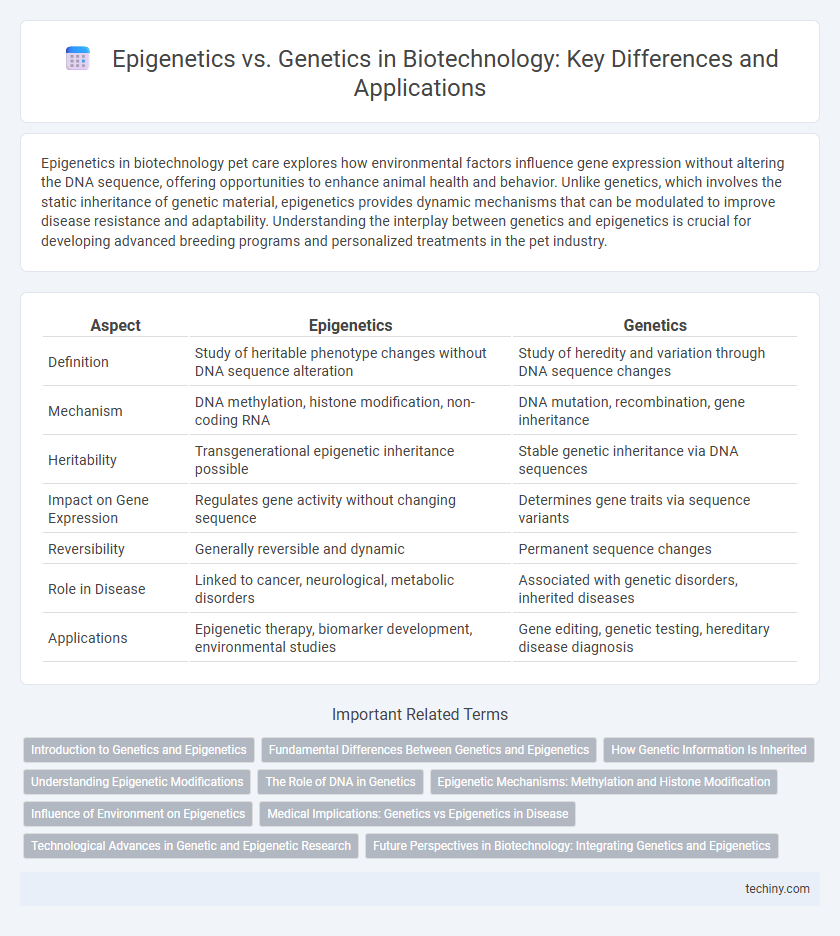Epigenetics in biotechnology pet care explores how environmental factors influence gene expression without altering the DNA sequence, offering opportunities to enhance animal health and behavior. Unlike genetics, which involves the static inheritance of genetic material, epigenetics provides dynamic mechanisms that can be modulated to improve disease resistance and adaptability. Understanding the interplay between genetics and epigenetics is crucial for developing advanced breeding programs and personalized treatments in the pet industry.
Table of Comparison
| Aspect | Epigenetics | Genetics |
|---|---|---|
| Definition | Study of heritable phenotype changes without DNA sequence alteration | Study of heredity and variation through DNA sequence changes |
| Mechanism | DNA methylation, histone modification, non-coding RNA | DNA mutation, recombination, gene inheritance |
| Heritability | Transgenerational epigenetic inheritance possible | Stable genetic inheritance via DNA sequences |
| Impact on Gene Expression | Regulates gene activity without changing sequence | Determines gene traits via sequence variants |
| Reversibility | Generally reversible and dynamic | Permanent sequence changes |
| Role in Disease | Linked to cancer, neurological, metabolic disorders | Associated with genetic disorders, inherited diseases |
| Applications | Epigenetic therapy, biomarker development, environmental studies | Gene editing, genetic testing, hereditary disease diagnosis |
Introduction to Genetics and Epigenetics
Genetics studies the inheritance of DNA sequences that dictate traits passed from parents to offspring, focusing on gene structure, function, and mutation. Epigenetics involves modifications beyond the DNA sequence, such as DNA methylation and histone modification, that regulate gene expression without altering the genetic code. Together, genetics and epigenetics provide a comprehensive understanding of how genes and environmental factors influence phenotype and disease development.
Fundamental Differences Between Genetics and Epigenetics
Genetics involves the study of DNA sequences that encode hereditary information, determining traits passed from parents to offspring through stable gene sequences. Epigenetics examines reversible modifications on DNA or histones, such as methylation and acetylation, that regulate gene expression without altering the underlying genetic code. Fundamental differences between genetics and epigenetics lie in the fixed nature of genetic information versus the dynamic, environment-responsive regulation of gene activity through epigenetic mechanisms.
How Genetic Information Is Inherited
Genetic information is inherited through the DNA sequence passed from parents to offspring, defining the organism's fundamental traits and biological functions. Epigenetics influences how genes are expressed without altering the DNA sequence by modifying DNA methylation and histone acetylation patterns, impacting gene activity across generations. These epigenetic modifications can be influenced by environmental factors, enabling dynamic regulation of inherited genetic information.
Understanding Epigenetic Modifications
Epigenetic modifications involve reversible changes to DNA or histones that regulate gene expression without altering the nucleotide sequence, differentiating them from genetic mutations. Key mechanisms include DNA methylation, histone acetylation, and non-coding RNA activity, which dynamically influence chromatin structure and transcriptional activity. Understanding these modifications provides insights into cellular differentiation, disease progression, and potential therapeutic targets in biotechnology.
The Role of DNA in Genetics
DNA serves as the foundational molecule in genetics, encoding the hereditary information that determines an organism's traits through sequences of nucleotides. Epigenetics involves modifications on DNA or associated proteins that influence gene expression without altering the nucleotide sequence itself, regulating how genes are turned on or off. Understanding the role of DNA in genetics provides insight into inherited genetic traits, while epigenetic mechanisms explain heritable changes in phenotype caused by environmental factors.
Epigenetic Mechanisms: Methylation and Histone Modification
Epigenetic mechanisms such as DNA methylation and histone modification play crucial roles in regulating gene expression without altering the underlying genetic code. DNA methylation typically involves the addition of methyl groups to cytosine bases, leading to gene silencing, while histone modifications, including acetylation and methylation, influence chromatin structure and accessibility. These epigenetic changes are dynamic and reversible, allowing cells to respond to environmental cues and developmental signals.
Influence of Environment on Epigenetics
Epigenetics involves chemical modifications that regulate gene expression without altering the DNA sequence, influenced significantly by environmental factors such as diet, stress, and toxins. Unlike genetics, which deals with fixed DNA sequences inherited from parents, epigenetic changes can be reversible and responsive to external environmental stimuli. This dynamic interaction between environment and epigenome plays a crucial role in disease development, aging, and cellular differentiation.
Medical Implications: Genetics vs Epigenetics in Disease
Genetics involves the study of inherited DNA sequences influencing disease susceptibility, while epigenetics examines heritable changes in gene expression without altering the underlying DNA. Epigenetic mechanisms such as DNA methylation and histone modification play critical roles in complex diseases like cancer, diabetes, and neurodegenerative disorders by regulating gene activity. Understanding both genetic mutations and epigenetic alterations enhances precision medicine approaches, enabling targeted therapies and improved disease diagnosis.
Technological Advances in Genetic and Epigenetic Research
Technological advances such as CRISPR-Cas9 and next-generation sequencing have revolutionized genetic research by enabling precise gene editing and comprehensive genome analysis. Epigenetic research benefits from high-throughput methods like bisulfite sequencing and chromatin immunoprecipitation sequencing (ChIP-seq), allowing detailed mapping of DNA methylation and histone modifications. Integration of multi-omics data accelerates understanding of gene regulation mechanisms, highlighting the dynamic interplay between genetics and epigenetics in development and disease.
Future Perspectives in Biotechnology: Integrating Genetics and Epigenetics
Future perspectives in biotechnology emphasize the integration of genetics and epigenetics to enhance precision medicine and personalized therapies. Advanced genomic editing tools like CRISPR-Cas9 combined with epigenetic modulation enable targeted interventions at both DNA sequence and chromatin structure levels. This integration promises breakthroughs in complex disease treatment, regenerative medicine, and agricultural biotechnology by harnessing dynamic gene regulation alongside stable genetic code alterations.
Epigenetics vs Genetics Infographic

 techiny.com
techiny.com